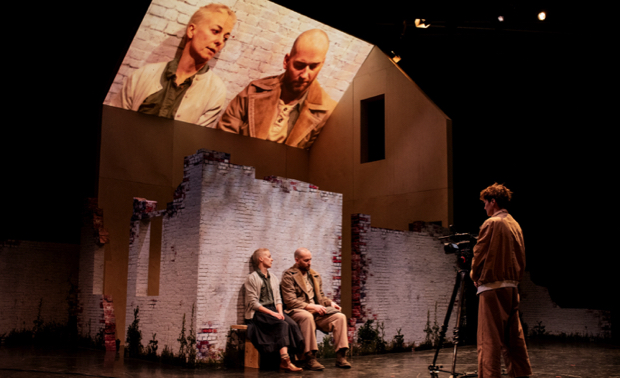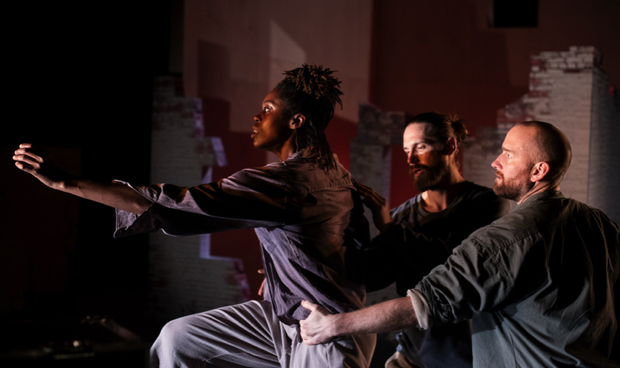Lost Dog, A Tale of Two Cities review ★★★★★
Ben Duke, the man who imagined Romeo and Juliet in discontented middle age, brings an iconoclastic retelling of Dickens’s A Tale of Two Cities to The Place
John Kendall and Nina-Morgane Madeleine in Lost Dog, A Tale of Two Cities. Photo: Camilla Greenwell
Charles Dickens’s A Tale of Two Cities is a long, very detailed novel set in Paris and London during the 1790s, the period of the French Revolution. The version now presented by Ben Duke’s company Lost Dog is, well, not quite that.
Chronology is not something that much bothers Ben Duke, or tethers his prodigious and irreverent imagination. His taking apart and reassembling of A Tale of Two Cities uses some of the original characters, namely Lucie Manette and her husband Charles Darnay, who flee the chaos and danger of revolutionary Paris for the safety of London. They bring with them their baby daughter Lucie, and it’s a grown-up Lucie who steers Lost Dog’s dance theatre version of A Tale of Two Cities.
In modern dress and armed with a videocamera, Lucie, played by the vivacious French performer Nina-Morgane Madeleine, is making a documentary which she hopes will drag the real story of her family and the circumstances of their flight from Paris from her tight-lipped parents.
As she films, images of her awkward interviews are projected on the mansard ceiling of the modest brick house (set design by Amber Vandenhoek) that anchors the action.

Valenina Formenti, Hannes Langolf, Nina-Morgane Madeleine in Lost Dog, A Tale of Two Cities. Photo: Camilla Greenwell
The back story is also enacted on stage, through plentiful text and a few movement interludes by Lost Dog’s excellent five-strong company of international performers: Valentina Formenti, playing Lucie’s mother; Hannes Langolf, her father; John Kendall, her brother; and Temitope-Ajose Cutting as Madame Lafarge, who is eventually shown to be key to the family history, as well as Nina Madeleine. They dance to an eclectic soundtrack that ranges from Bellini to a traditional folk song.
As fragments of the story start to emerge, each performer enacts other subsidiary characters that help Lucie find the answers she craves, but not the ones she hoped for; and after 100 minutes of frantic, heavy-duty storytelling, Lost Dog’s A Tale of Two Cities ends in downbeat, melancholy mood.
This is a work about family secrets, broken memories, and the lies we tell ourselves and those we love, and about the wisdom or otherwise of unearthing the past.
Some of its dance interludes are arresting, for example, when Madame Lafarge expresses her grief at the abduction, rape and murder of her young sister by two relatives of Charles Darnay.

Temitope-Ajose Cutting, Hannes Langolf, John. Kendall in Lost Dog, A Tale of Two Cities. Photo: Camilla Greenwell
However, Lost Dog’s A Tale of Two Cities is hard work for the audience, its intricate, fast-moving, fragmentary storytelling quite exhausting and at times offputting. Believe Lucie when she bursts onto the stage clutching a clipboard and advises you to pay attention and take notes – what seems a bit of whimsy to warm up the audience proves wise advice indeed.
A Tale of Two Cities runs at The Place, which co-commissioned the work, for 10 performances as part of an extensive national tour.
Age Recommendation: 12+
Chronology is not something that much bothers Ben Duke, or tethers his prodigious and irreverent imagination. His taking apart and reassembling of A Tale of Two Cities uses some of the original characters, namely Lucie Manette and her husband Charles Darnay, who flee the chaos and danger of revolutionary Paris for the safety of London. They bring with them their baby daughter Lucie, and it’s a grown-up Lucie who steers Lost Dog’s dance theatre version of A Tale of Two Cities.
In modern dress and armed with a videocamera, Lucie, played by the vivacious French performer Nina-Morgane Madeleine, is making a documentary which she hopes will drag the real story of her family and the circumstances of their flight from Paris from her tight-lipped parents.
As she films, images of her awkward interviews are projected on the mansard ceiling of the modest brick house (set design by Amber Vandenhoek) that anchors the action.

Valenina Formenti, Hannes Langolf, Nina-Morgane Madeleine in Lost Dog, A Tale of Two Cities. Photo: Camilla Greenwell
The back story is also enacted on stage, through plentiful text and a few movement interludes by Lost Dog’s excellent five-strong company of international performers: Valentina Formenti, playing Lucie’s mother; Hannes Langolf, her father; John Kendall, her brother; and Temitope-Ajose Cutting as Madame Lafarge, who is eventually shown to be key to the family history, as well as Nina Madeleine. They dance to an eclectic soundtrack that ranges from Bellini to a traditional folk song.
As fragments of the story start to emerge, each performer enacts other subsidiary characters that help Lucie find the answers she craves, but not the ones she hoped for; and after 100 minutes of frantic, heavy-duty storytelling, Lost Dog’s A Tale of Two Cities ends in downbeat, melancholy mood.
This is a work about family secrets, broken memories, and the lies we tell ourselves and those we love, and about the wisdom or otherwise of unearthing the past.
Some of its dance interludes are arresting, for example, when Madame Lafarge expresses her grief at the abduction, rape and murder of her young sister by two relatives of Charles Darnay.

Temitope-Ajose Cutting, Hannes Langolf, John. Kendall in Lost Dog, A Tale of Two Cities. Photo: Camilla Greenwell
However, Lost Dog’s A Tale of Two Cities is hard work for the audience, its intricate, fast-moving, fragmentary storytelling quite exhausting and at times offputting. Believe Lucie when she bursts onto the stage clutching a clipboard and advises you to pay attention and take notes – what seems a bit of whimsy to warm up the audience proves wise advice indeed.
A Tale of Two Cities runs at The Place, which co-commissioned the work, for 10 performances as part of an extensive national tour.
Age Recommendation: 12+
TRY CULTURE WHISPER
Receive free tickets & insider tips to unlock the best of London — direct to your inbox
| What | Lost Dog, A Tale of Two Cities review |
| Where | The Place, 17 Duke's Road, London, WC1H 9PY | MAP |
| Nearest tube | Euston (underground) |
| When |
23 Feb 22 – 05 Mar 22, 19:30. Sat 5 March at 15:00 Dur.: 90 mins no interval |
| Price | £20 (concessions £13) |
| Website | Click here to book |